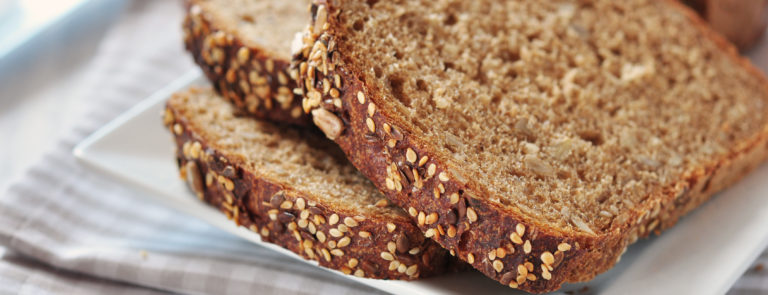10% off £25 OR 15% off £35
Code:DEAL

5 of the healthiest breads
23 Nov 2022 • 1 min read
- Health Hub Home
- Food & Drink
- Nutrition
- 5 of the healthiest breads
Are you a health-conscious bread lover? If a lunchtime sandwich or morning tea and toast is part of your daily routine, you’ll be pleased to know that bread can feature as part of a healthy and balanced diet. The key is finding a suitably healthy bread that’s as nutritious as it is tasty.
What is healthy bread?
First off, let’s dispel the myth that bread is bad for you. Not all breads are the same, and whilst it’s true that some breads have a questionable health rating, bread can also be a valuable source of fibre and vitamins and minerals. Choose the right loaf of bread can help lower cholesterol, aid digestion and even help regulate blood sugars.1 This simple guide will help you find a healthy bread that you can enjoy and feel good about eating.How to identify healthy bread
There are some common ingredients of healthy bread, including:Fibre
Look for fibre rich breads. Fibre is an essential part of a healthy balanced diet and can support a healthy digestive system. Adults need on average 30g a day of fibre a day to maintain a healthy gut.2 So, choosing a loaf with a high fibre content is a good way to help reach that daily target.Wholegrains
Choosing a 100% wholegrain, unrefined bread will help ensure you’re getting the maximum nutritional value from your daily slice of toast. Wholegrains are a great source of fibre.3Avoid additives
Some breads may look healthy but check the ingredients – sugar and additives may be lurking inside even the most nutritious and innocent looking loaves. So, check before you buy.5 types of healthy bread
From sourdough, to wholewheat, rye, buckwheat and spelt, there’s a host of healthy options to make bread part of your balanced diet.1. Sourdough bread
Sourdough bread is a healthy option thanks to its unique nutritional composition and fermentation process. This is both good for our gut and also for mineral absorption. Not only that, sourdough has a low glycemic index, so is less likely to cause a spike in blood sugar. Plus, if you know how to make your own sourdough bread at home, you get the added bonus of knowing exactly what’s in it.2. Rye bread
High in iron, potassium, calcium, zinc and soluble fibre, rye bread is a dark, dense bread with a distinctive earthy taste. Rye bread is considered more nutritious than wheat bread. As well as being super filling, it also contains more fibre and B vitamins than wheat breads. And whilst it’s not entirely gluten free, it does contain less gluten than regular wheat bread alternatives.3. Buckwheat bread
Despite its name, buckwheat flour is not in fact derived from wheat. As a result, it’s suitable for people with a gluten intolerance and Coeliac disease. Buckwheat is also a source of fibre and manganese, which may promote heart health.44. Spelt bread
Made from spelt flour rather than wheat flour, spelt bread contains gluten and has very similar nutritional values to wheat bread. High in wholegrain fibre it has health benefits such as aiding digestion.5. Wholewheat bread
Full of fibre and wholegrain goodness, wholewheat bread is one of the most popular bread choices. It is readily accessible on most supermarket shelves. Always check the label to make sure the loaf you’re choosing is 100% whole grain rather than a blend of refined and whole grains.White bread?
With white bread occupying so much space on supermarket shelves it would be remiss not to give it a mention. But is white bread healthy? The short answer is no, not really. Of course, every loaf is different, but as a general rule, white bread is made from refined flour. This process strips the wheat down, removing valuable nutrients including vitamins and minerals. What is left has minimal nutritional value.Healthy bread – a quick guide to nutritional values
Interested in the finer details? Check out the fibre, calorie and carb content of these healthy breads:5| Bread type | Fibre (g per 100g) | Calories per 100g | Carbohydrates (g per 100 g) |
| Sourdough bread | 3 | 120 | 20 |
| Rye bread | 5.8 | 259 | 48 |
| Buckwheat bread | 4.3 | 213 | 43 |
| Spelt bread | 3.6 | 185 | 36 |
| 100% wholewheat bread | 6.7 | 305 | 56.4 |
| White bread | 0.7 | 266 | 49 |
Summary: Healthy bread exists
Eaten in moderation, healthy bread can be part of a balanced diet. You just need to choose your loaf carefully. Think fibre rich, 100% wholegrain, unrefined and additive free and you won’t go too far wrong. Last updated: 4 August 2020 Sources 1 https://www.healthline.com/nutrition/9-benefits-of-whole-grains 2 https://www.healthline.com/nutrition/9-benefits-of-whole-grains 3 https://www.healthline.com/nutrition/9-benefits-of-whole-grains 4 https://pubmed.ncbi.nlm.nih.gov/7840076/ 5 https://www.eatthismuch.com/food/browseSign up for exclusive offers
Plus, get expert advice to support your health & wellness straight to your inbox when you sign up to Holland & Barrett emails.
Read our
privacy policy


